The Timeline Mural, 1970 - 1990
2012

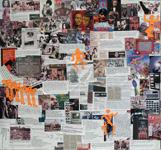
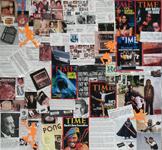
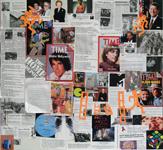
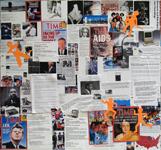
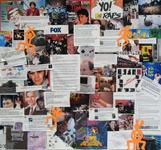
The incarcerated youth at Monroe County Jail were so proud of their work on The Timeline Mural, 1950 – 1970 they asked if the mural could be in Visiting Room so they could show their children, parents, and other relatives what they were part of. They became engaged academically with history as their literacy, communication, problem solving and critical thinking skills were developed through expressing the time period visually working with visual artist Margot Muto on the historical collage while verbally discussing the impact people, places, and historical events have had on Rochester.
Research and the use of community resources remained at the core as The Timeline Mural, 1970 – 1990 built upon the success of The Timeline Mural, 1950 – 1970. Dale Davis’s research included local history resources, the Monroe County Library System and collaboration with The University of Rochester Rare Books, Special Collections, and Preservation, including on-line access to the Rochester Black Freedom Struggle On-Line Project. Research included both the beginning of the digital revolution and hip-hop culture.
Dale Davis built upon the collage approach to learning history she developed in The Timeline Mural 1950 - 1970 with technology, Xerox and Kodak, ARPANET to the Internet, the first email, HBO, Shirley Chisholm, Watergate, the Post-it note, the MRI, the laser printer, Apple, "The Godfather," the VCR, Midtown Tower Hotel closing, Sandra Day O'Connor, AIDS, Polar Fleece and Donkey Kong, Vietnam Veterans Memorial, Marketplace Mall, Sally Ride, CD's, Domain Name System, Fall of the Berlin Wall, and Teresa D. Johnson. The Timeline Project 1970 – 1990 included a playlist to accompany it.
“Surprises.” The Last Poets. 1970.
“What’s Going On.” Marvin Gaye. 1971.
“Pieces of A Man.” Gil Scott-Heron. 1971.
“Rappers Delight.” Sugar Hill Gang. 1979.
“The Breaks.” Kurtis Blow. 1980.
“The Adventures of Grandmaster Flash On The Wheels of Steel.” Grandmaster Flash. 1981.
“Plant Rock.” Afrika Bambaata and SoulSonicforce. 1982.
“The Message.” Grandmaster Flash and the Furious Five. 1982.
“It’s Like That.” Run-DMC. 1983.
“The Show.” Doug E. Fresh. 1985.
“I Can’t Live Without My Radio.” L.L Cool J. 1985.
“Eric B Is President.” Eric B. and Rakim. 1986.
“Bring The Noise.” Public Enemy. 1987.
The timeline was constructed in six sections to enable it to be displayed at both Monroe County Jail and Monroe Correctional Facility, and in the community.
NYSLC is grateful to The University of Rochester Rare Books, Special Collections, and Preservation, including on-line access to the Rochester Black Freedom Struggle On-Line Project and to the Rochester Public Library.
The Timeline Mural, 1970 – 1990 was located in Monroe County Jail adjacent to The Jimmy Santiago Baca Library, Writing, and Publishing Center, NYSLC’s classroom, during the time NYSLC conducted programs for incarcerated youth at Monroe County Jail. It was not moved to Monroe Correctional Facility. In 2019 it was unable to be located at Monroe County Jail.
WRITING ON THE TIMELINE MURAL, 1970 – 1990
1970's
Poor Black people crying
because of the pain,
crying
and fighting for freedom.
Why to stop violence do you have to be violent?
L.
1971
Where is the future?
Vietnam.
Brothers dying.
Brothers killing each other.
Where is the future?
War is not the answer.
J.
1971
How is a man a man?
If he does not have the opportunity to get a job,
if he cannot support his family,
if he cannot take care of his responsibilities,
what will he do for that dollar?
M.
1970's, 1980's
I notice many things were founded in Rochester, Kodak, Xerox, but people did not take the risks going with new things with them. Our city was very successful and what happened to Kodak and Xerox? Why didn't people believe new ideas?
If you listen to the music from the 1970's and 1980's, you can tell how much things have changed.
A.
1970's
Poverty,
always poverty.
In the 1970's poverty
looks the same as it does today.
It's just different people.
J.
How many people died in the Vietnam War? Why do people think war is the answer? We will never stop the world from fighting, that's why we can't find any way to keep our minds on how things can be all right.
I'm learning about when things happened and how things were different back then. We need to know about the world to change the world.
P.
What would things be like if John Lennon was alive now and the Beatles were still together? The world was different in the 1980's. For one, there were no VCR's.
Music shows how people are doing, like in the 1980's and today. Music shows how the times have changed. So much is different today than it was in the 1980's. What is the same is no jobs.
P.
1971
It is as if the world is literally falling to pieces,
one person at a time.
People are dying,
and don’t have what is needed
to survive.
It kind of sounds like our world
right now.
O.
1980's
I think how in the 1980's how different things would have been if people really paid attention to the art, the music. People put their thoughts into the music and rapped what was there.
Why didn't people listen? If people listened things might have changed for children growing up in the ghetto.
A child is born with no state of mind
Blind to the ways of mankind
God is smiling on you but he's frowning too
Because only God knows what you'll go through
You'll grow in the ghetto living second-rate
And your eyes will sing a song of deep hate
The places you play and where you stay
Looks like one great big alleyway
Grandmaster Flash and The Furious Five. The Message, 1983.
P.
What I am learning from the Timeline is that Blacks started a lot of things we do today. I am learning Black people did more for me than I thought, like create music that I listen to everyday of my life.
S.
The Times
Kent State shootings,
Super horse, Secretariat,
Watergate broke wide open,
A president resigns,
Travolta fever,
Mr. Hollywood, Warren Beatty,
When the music died, John Lennon,
Super shark, Jaws,
Golden oldies, Hepburn and Fonda,
Frazier vs. Ali,
Bruce Springsteen,
Nintendo,
AIDS,
Here they come Prince Charles and Diana,
computers connected.
Shirley Chisholm ran for President. Why wasn't hip-hop in the mainstream? Was Kurtis Blow ever on the cover of Time? Or Grandmaster Flash or Run DMC?
Why did it take from 1985 until 1989 for YO! MTV RAPS to be on MTV?
What's going on?"
What is American culture? Is it war, drugs, oil, music, McDonald's, gangs, poverty?
M.
1970’s
It is sad to watch drugs ruin lives.
It is sad to think the founding father of hip-hop, Kool Herc, is fifty-five in bad health with no health insurance. He created the breakbeat technique. He rallied to save 1520 Sedgwick Avenue, the birthplace of hip-hop where he spun records.
"To me, hip-hop says, 'Come as you are. We are a family. It ain't about security. It ain't about bling-bling. It ain't about how much your gun can shoot. It ain't about $200 sneakers. It is not about me being better than you or you being better than me. It's about you and me, connecting as one.
D.J. Kool Herc. “Introduction.” Can’t Stop Won’t Stop: A History of The Hip-Hop Generation. New York: St. Martin’s Press, 2005.
J.
1980's
John Lennon shot down.
President Ronald Reagan shot,
and J. R. in the TV show Dallas was shot.
Eighty-three million people watched Dallas to see who shot J.R.
B.
Questions
Why do Black Americans get paid less than White Americans?
Why is it us against them?
Why is it so hard for young Black men to get an education?
Why do we get paid so little?
Why is it hard to get a job,
but easy to go to war?
Why is peace the hardest thing to get
back in the day and now?
Out of everything we do,
why don’t people understand our pain?
Why are brothers dying
still to this day¿
What do we do with all of our memories
when we get home from jail?
A.
The Timeline Mural, 1970 - 1990 was made possible with funding from The Guido and Ellen Palma Foundation, The Marie C. and Joseph C. Wilson Foundation, and the Mary S. Mulligan Charitable Trust.
©2019 Dale Davis, The New York State Literary Center
